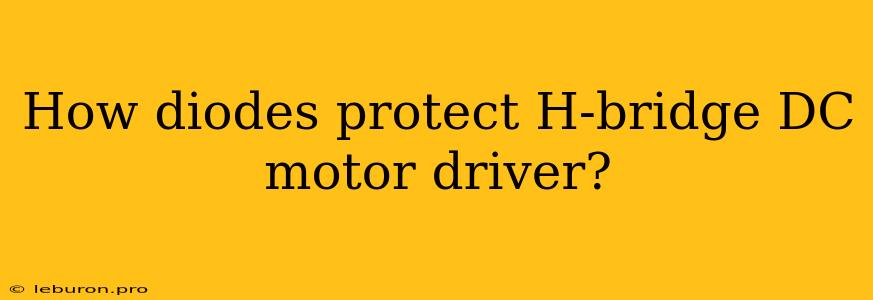How Diodes Protect H-Bridge DC Motor Drivers: A Comprehensive Guide
H-bridges, ubiquitous in motor control applications, allow bidirectional control of DC motors by switching the polarity of the voltage applied to the motor. However, the inherent nature of inductive loads like DC motors can lead to dangerous voltage spikes if not carefully managed. Diodes play a crucial role in mitigating these risks, safeguarding both the H-bridge circuitry and the motor itself. This article will delve into the workings of H-bridge drivers, the potential issues arising from inductive loads, and the critical role diodes play in protecting the system.
Understanding H-Bridge Drivers: The Foundation of Motor Control
H-bridges, named for their resemblance to the letter "H" in circuit diagrams, act as electronic switches to control the direction and speed of DC motors. They consist of four switching elements, typically transistors, arranged in a bridge configuration.
Here's how an H-bridge operates:
- Forward Motor Rotation: To rotate the motor forward, one pair of switches in the H-bridge is turned on, applying positive voltage to the motor's positive terminal and negative voltage to its negative terminal.
- Reverse Motor Rotation: Switching the on state to the other pair of switches reverses the polarity applied to the motor, causing it to rotate in the opposite direction.
- Braking: By turning off all switches, the motor is disconnected from the power supply, allowing it to decelerate due to friction and other resistive forces.
- PWM Control: H-bridges often employ Pulse Width Modulation (PWM) to control the motor's speed. PWM varies the duty cycle of the switches, effectively controlling the average voltage applied to the motor, thereby regulating its speed.
The Challenge of Inductive Loads: Voltage Spikes and Back EMF
DC motors, like all inductive loads, possess a characteristic known as back electromotive force (back EMF). When the motor rotates, it generates a counter-voltage opposing the applied voltage. This back EMF can become significant when the motor is abruptly stopped or its direction reversed.
Here's why back EMF poses a threat:
- Voltage Spikes: When the current flowing through the motor coil is interrupted, the collapsing magnetic field induces a high voltage spike across the coil. This spike can be several times the original supply voltage, potentially damaging the H-bridge switches and other components.
- Switch Damage: If the voltage spike exceeds the breakdown voltage of the H-bridge switches, they can be damaged, leading to failures and malfunctions in the motor control system.
Diodes: The Guardians Against Voltage Spikes
Diodes are semiconductor devices that allow current to flow in only one direction. In an H-bridge circuit, diodes are strategically placed across each switching element to provide a path for the back EMF current, effectively preventing it from damaging the H-bridge components.
Here's how diodes protect the H-bridge:
- Freewheeling Current Path: When a switch in the H-bridge is turned off, the diode connected across it becomes forward-biased, providing a path for the back EMF current to flow. This effectively bypasses the switch, preventing the voltage spike from building up.
- Reduced Voltage Spikes: The diode's presence allows the back EMF energy to dissipate safely through the motor windings, minimizing the magnitude of the voltage spike and protecting the switches from damage.
- Minimized Switch Stress: By providing a path for the current to flow, diodes reduce the rate of current change through the switches, reducing the stress placed on them during switching operations.
Types of Diodes Used in H-Bridge Drivers
Two common types of diodes are primarily used in H-bridge circuits:
- Standard Diodes: These are basic rectifier diodes that allow current flow in one direction only. They are suitable for most general-purpose H-bridge applications.
- Schottky Diodes: These diodes offer lower forward voltage drop compared to standard diodes, leading to improved efficiency. They are particularly beneficial in high-frequency applications where efficiency is crucial.
Choosing the Right Diode for Your Application
The choice of diode for an H-bridge application depends on various factors:
- Current Rating: The diode's current rating must be higher than the maximum motor current expected in the application.
- Voltage Rating: The diode's voltage rating should exceed the maximum expected voltage spike, ensuring safe operation.
- Switching Speed: In high-frequency applications, Schottky diodes with their faster switching speeds are preferred.
- Cost: Standard diodes are generally more cost-effective than Schottky diodes.
Benefits of Diode Protection in H-bridge Drivers
Implementing diode protection in H-bridge drivers offers several advantages:
- Enhanced Reliability: Diodes effectively prevent damage to the switches, contributing to a more robust and reliable motor control system.
- Increased Life Expectancy: Protection against voltage spikes significantly extends the life of the H-bridge switches and the motor itself.
- Improved Efficiency: The freewheeling path provided by diodes allows for smoother current transitions, improving overall system efficiency.
- Reduced Electromagnetic Interference (EMI): Diode protection reduces the magnitude of voltage spikes, minimizing EMI emissions.
Conclusion: Diode Protection – A Must for H-Bridge Drivers
Diodes are essential for protecting H-bridge DC motor drivers from the detrimental effects of inductive loads. They effectively mitigate voltage spikes generated by back EMF, ensuring the safe operation of the motor control system. By providing a path for the back EMF current, diodes enhance reliability, extend component life, and improve overall system efficiency. Implementing diode protection is a critical step in designing robust and reliable DC motor control systems.
